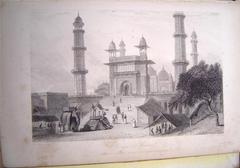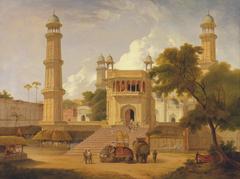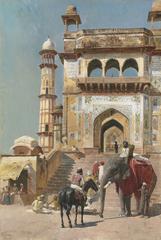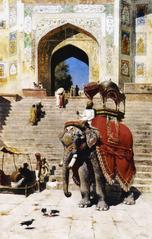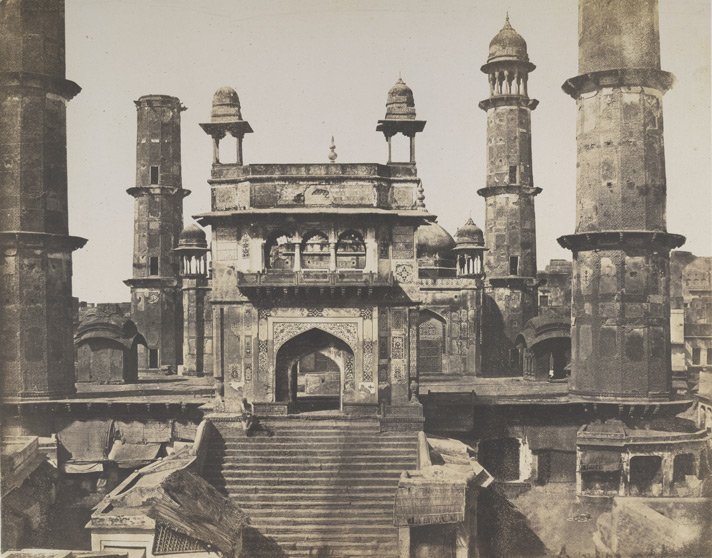
Visiting Jama Mosque Mathura, India: Complete Guide to Tickets, Hours, Architecture, and Travel Tips
Date: 15/06/2025
Introduction
Jama Mosque Mathura stands as a magnificent testament to Mughal-era architecture and the city’s rich, pluralistic heritage. Constructed in 1661 CE under the patronage of Abd-un-Nabi Khan during Emperor Aurangzeb’s reign, the mosque is an enduring symbol of Mathura’s layered history. Its grand domes, soaring minarets, and intricate calligraphy reflect the artistic mastery of Indo-Islamic design, while its central location near revered Hindu temples underscores centuries of interfaith dynamics. Today, Jama Mosque Mathura draws travelers, pilgrims, and history enthusiasts eager to experience its spiritual ambiance and architectural splendor. This guide offers essential information for visiting, including hours, entry, etiquette, accessibility, and highlights of nearby attractions, ensuring a respectful and enriching experience (TravelTriangle; Holidify; bhramanam.com).
Contents
- Jama Mosque Mathura: Origins and Historical Context
- Architectural Features and Artistic Highlights
- Cultural Significance and Community Role
- Visiting Information: Hours, Tickets, Accessibility, and Travel Tips
- Etiquette and Respectful Conduct
- Nearby Attractions and Suggested Itineraries
- Practical Visitor Tips
- Frequently Asked Questions (FAQ)
- Conclusion and Call to Action
- Sources and Further Reading
Jama Mosque Mathura: Origins and Historical Context
Constructed in 1661 CE, Jama Mosque Mathura was commissioned by Abd-un-Nabi Khan, the Mughal-appointed Governor of Mathura under Emperor Aurangzeb (TravelTriangle). This era was marked by the proliferation of grand Islamic monuments across North India, reflecting Mughal authority and aesthetic sensibilities. The mosque’s location in Mathura—a city celebrated as the birthplace of Lord Krishna—highlights the complex interplay of religious and cultural influences prevalent during the Mughal period (The Imperial Tours; Vrindavan Mathura Tourism).
The mosque not only served as a spiritual center for the local Muslim community but also as a statement of Mughal presence in a predominantly Hindu region. Its proximity to significant Hindu sites, such as Krishna Janmabhoomi Temple, stands as a testament to Mathura’s enduring pluralism and interfaith interactions.
Architectural Features and Artistic Highlights
Location, Layout, and Structure
Jama Mosque Mathura is situated atop the city’s highest point, set on a raised red sandstone plinth that offers panoramic views of Mathura (IndoIslamic.org). The mosque features a spacious courtyard with a central ablution pool for ritual purification.
Minarets and Domes
The mosque is distinguished by four imposing minarets, each approximately 40 meters tall, capped with chhatris typical of Indo-Islamic design (Holidify). Three bulbous domes—central dome being the largest—rise above the prayer hall, symbolizing the heavens and enhancing acoustics.
Gateways, Pavilions, and Ornamentation
A grand gateway adorned with intricate tile work and geometric floral motifs welcomes visitors. The courtyard contains symmetrical pavilions with Bangla roofs and ogival arches, blending Persian and Indian artistic traditions (IndoIslamic.org). The prayer hall facade is inscribed with the 99 names of Allah in Persian script, showcasing masterful Mughal calligraphy (Holidify).
The mosque’s ornamentation features floral patterns, geometric jalis (lattice screens), and colorful mosaic plasterwork. The red sandstone structure is accentuated with white marble and vibrant tiles, reflecting sunlight and creating a dynamic visual ambiance.
Indo-Saracenic and Mughal Influences
Jama Mosque Mathura embodies the Indo-Saracenic style—melding Islamic elements like arches and domes with indigenous Indian features such as Bangla roofs (IndoIslamic.org). Symmetry, calligraphy, and geometric designs highlight its Mughal heritage.
Cultural Significance and Community Role
Beyond its architectural prowess, Jama Mosque Mathura remains an active center of religious and community life. It hosts daily prayers, Friday congregations, and celebrations of Islamic festivals such as Eid-ul-Fitr and Eid-ul-Adha (TravelTriangle). The mosque also serves as a venue for educational and charitable activities, underscoring its importance as a living institution in Mathura’s diverse cultural landscape.
Visiting Information: Hours, Tickets, Accessibility, and Travel Tips
Hours and Entry
- Visiting Hours: Typically open daily from 6:00 AM to 7:00 PM. Hours may be adjusted for festivals or special occasions; check with local sources or mosque staff for updates.
- Entry Fee: There is no entry fee; visitors are welcome free of charge. Donations are appreciated but not mandatory (bhramanam.com; travelsetu.com).
Location and Accessibility
-
Address: Dampier Nagar, Mathura, Uttar Pradesh, centrally located near major historical sites (bhramanam.com; Wikipedia).
-
By Air: Agra Airport is the nearest, about 60 km away.
-
By Rail: Mathura Junction is a major railway hub with easy access to the mosque.
-
By Road: The city is well-connected by highways and local transport.
-
Accessibility: The mosque is accessible to most visitors, though some areas may have steps or uneven surfaces. Ramps and spacious courtyards assist those with limited mobility, but full wheelchair access may be restricted due to the historic plinth.
Visitor Facilities
- Footwear must be removed before entering the prayer hall; racks are provided (Wikipedia).
- Modest dress is required: cover arms and legs; women are advised to cover their heads.
- Restrooms are limited; public facilities are nearby.
- Guided tours may be available locally for a fee (bhramanam.com).
Etiquette and Respectful Conduct
Attire and Behavior
- Dress Code: Wear modest clothing; men and women should cover shoulders, arms, and knees. Women should bring a scarf for head covering (Blue Mosque Guide).
- Footwear: Remove shoes before entering the mosque.
- Silence: Keep noise to a minimum. Silence mobile phones and avoid loud conversations.
- Respect Prayer Times: Non-Muslims are welcome outside main prayer times; Fridays and festival days are especially busy.
- Photography: Allowed in most areas, but always request permission before photographing people or during prayers. Flash photography is discouraged (Moments Log).
- Physical Boundaries: Do not cross restricted areas or enter the mihrab/minbar.
- Donations: Voluntary contributions support mosque maintenance (Moments Log).
Cultural Sensitivity
- Greet locals respectfully; “As-salamu alaykum” is appreciated but not required.
- Avoid discussing sensitive religious or political topics.
- Patronize nearby shops to support the community (Blue Mosque Guide).
- Use bins for litter; do not disturb plants or site features.
Nearby Attractions and Suggested Itineraries
Jama Mosque’s central location makes it an excellent starting point for exploring Mathura’s heritage:
- Shri Krishna Janmabhoomi Temple: A major Hindu pilgrimage site just a short walk away (Indian Holiday).
- Dwarkadhish Temple: Known for vibrant architecture and festivals, about 2 km from the mosque (Travel Setu).
- Vishram Ghat: Revered riverfront with evening aarti, 1.5 km away (NRI Travelogue).
- Government Museum: Showcases Mathura’s ancient art, around 3 km away.
- Kans Qila: Historic riverside fort blending Hindu and Mughal architecture.
- Prem Mandir (Vrindavan), Govardhan Hill, Barsana, and Nandgaon: Sites of religious and historical interest nearby (Travel World Planet).
A visit to Jama Mosque can be comfortably included in half-day or full-day itineraries (makemytrip.com).
Practical Visitor Tips
- Best Time to Visit: October to March offers pleasant weather. Major festivals like Holi and Janmashtami bring vibrant celebrations but larger crowds (Indian Holiday).
- Transportation: Use local auto-rickshaws or taxis for short distances.
- Safety: The area is generally safe; standard precautions apply.
- What to Bring: A scarf, water (for outside), and a camera (respecting guidelines).
- Language: Hindi is widely spoken; basic English is understood by most guides and staff.
Frequently Asked Questions (FAQ)
Q1: What are the visiting hours for Jama Mosque Mathura?
A1: Typically from 6:00 AM to 7:00 PM, but hours may vary during festivals.
Q2: Is there an entry fee or ticket required?
A2: No, entry is free. Donations are welcome.
Q3: Can non-Muslims visit the mosque?
A3: Yes, non-Muslims are welcome outside main prayer times.
Q4: Are guided tours available?
A4: Local guides may be available on-site; check with nearby travel centers.
Q5: What is the dress code?
A5: Modest clothing covering arms and legs; women should cover their heads inside the mosque.
Q6: Is photography allowed?
A6: Yes, but request permission and avoid photographing worshippers or during prayers.
Q7: How accessible is the mosque for those with mobility needs?
A7: The mosque offers ramps and spacious areas, but full wheelchair access may be limited due to steps.
Conclusion and Call to Action
Jama Mosque Mathura is a living monument that encapsulates the city’s historical depth, architectural brilliance, and vibrant multicultural spirit. Its continued use and careful preservation speak to the enduring legacy of the Muslim community in a city renowned for its Hindu heritage. By visiting with respect for local customs and etiquette, and by exploring nearby attractions, travelers can gain a richer appreciation of Mathura’s unique tapestry of faith and history.
To enhance your experience, utilize interactive maps, virtual tours, and mobile applications such as the Audiala app for real-time updates and detailed guides. For more travel tips and in-depth articles on Mathura’s historical sites, explore our related content and follow us on social media.
Image Suggestions
- Exterior: “Jama Mosque Mathura facade showcasing Islamic architecture”
- Interior: “Inside Jama Mosque Mathura prayer hall”
- Map: “Map showing Jama Mosque Mathura and surrounding historical sites”
Related Articles
Sources and Further Reading
- TravelTriangle
- Holidify
- IndoIslamic.org
- bhramanam.com
- travelsetu.com
- Indian Holiday
- Moments Log
- Vrindavan Mathura Tourism
- Tusk Travel
- RajasthanDriver
- Blue Mosque Guide
- NRI Travelogue
- Travel World Planet
- Wikipedia
- makemytrip.com
- The Imperial Tours

